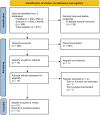Effects of conservative treatment strategies for iliotibial band syndrome on pain and function in runners: a systematic review
- PMID: 39247485
- PMCID: PMC11377285
- DOI: 10.3389/fspor.2024.1386456
Effects of conservative treatment strategies for iliotibial band syndrome on pain and function in runners: a systematic review
Abstract
Introduction: This systematic review summarizes the efficacy of conservative treatment strategies on pain and function in runners with iliotibial band syndrome (ITBS), a prevalent running injury constituting about 10% of all running-related injuries. The multifactorial nature of ITBS necessitates diverse treatment approaches; yet, a consensus on an optimal conservative regimen remains unreported. This review seeks to update and expand upon existing literature with recent rehabilitative approaches.
Methods: A systematic search was conducted in Medline, Web of Science, and CINHAL databases, from inception to June 31, 2024. Inclusion criteria were: (1) reporting of conservative treatments for ITBS in adult runners and (2) pain and function defined as main outcome parameters. The methodological quality was evaluated using the NIH Quality Assessment Tool.
Results: Thirteen out of 616 records met the inclusion criteria (201 participants), including five randomized controlled trials, one case-control study, one pre-test post-test study, and six case studies. Different active and passive treatment strategies were applied as single (five studies) or combined (eight studies) treatments. The average methodological quality was deemed good. Large between-study heterogeneity was present, impeding a meta-analysis to be performed. Hip abductor strengthening (HAS) exercise emerged as a common strategy. The intervention effects on pain reduction ranged from 27% to 100%, and functional improvement from 10% to 57%, over 2 to 8 weeks.
Conclusion: A conservative treatment approach incorporating HAS exercises, possibly augmented by shockwave or manual therapy, is effective for mitigating pain and enhancing function in ITBS-afflicted runners. Finally, the potential of emerging strategies like gait retraining requires further exploration through rigorous trials and comprehensive evidence. Addressing these gaps could refine ITBS management, enhancing treatment outcomes and facilitating runners' return to sport.
Keywords: muscle training; non-surgical; physical therapy; rehabilitation; running-related injury.
© 2024 Sanchez-Alvarado, Bokil, Cassel and Engel.
Conflict of interest statement
The authors declare that the research was conducted in the absence of any commercial or financial relationships that could be construed as a potential conflict of interest.
Figures



References
-
- Macintyre J, Taunton J, Clement D, Lloyd-Smith D, Mckenzie D, Morrell R. Running injuries: a clinical study of 4,173 cases. Clin J Sport Med. (1991) 1:81–7. 10.1097/00042752-199104000-00002 - DOI
-
- Geisler PR, Lazenby T. Iliotibial band impingement syndrome: an evidence-informed clinical paradigm change. Int J Athl Ther Train. (2017) 22(3):1–11. 10.1123/ijatt.2016-0075 - DOI
Publication types
LinkOut - more resources
Full Text Sources
Miscellaneous

